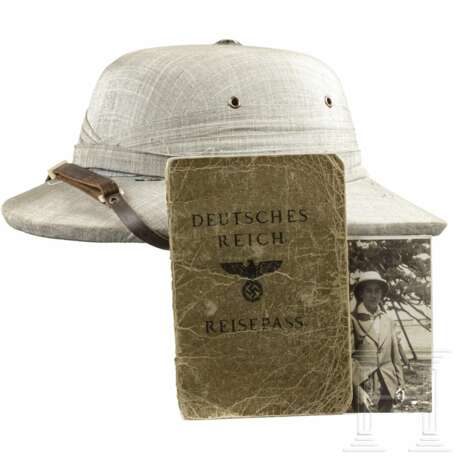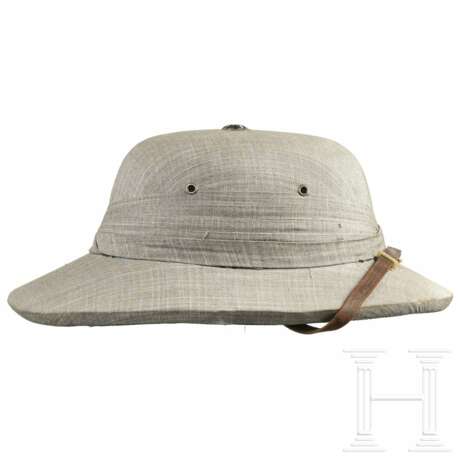Nachlass von Margarete Böving - Reisepass, Tropenhut und Beileidsschreiben 1939 von Eugen Ott, deutscher Botschafter in Tokio
25.06.2021 10:00UTC +01:00
Classic
Sold
220EUR € 220
| Auctioneer | Hermann Historica |
|---|---|
| Event location | Germany, Grasbrunn / München |
| Buyer Premium | 25 % |
Archive
The auction is completed. No bids can be placed anymore.

ID 576397
Lot 12544 | Nachlass von Margarete Böving - Reisepass, Tropenhut und Beileidsschreiben 1939 von Eugen Ott, deutscher Botschafter in Tokio
Estimate value
€ 220
Konvolut 30er Jahre, dabei ein Beileidsschreiben des deutschen Botschafters in Tokio, Eugen Ott, 1939, mit Tintenunterschrift, auf offiziellem Papier der Botschaft: "Sehr geehrter Frau Böving, ich höre mit großem Bedauern vom Tode Ihres Mannes........Ihr sehr ergebener Ott". Der von 1934 bis 1942 als Botschafter und Militärattaché in Japan eingesetzte Eugen Ott war schon früh politisch engagiert, er verwickelte sich 1932 in Planspiele der Reichswehr rund um General Schleicher. Hitler beließ Ott zunächst an der Spitze der Wehrmachts-Abteilung. Gerüchte, Ott wäre Hitlers Agent im Kreise Schleicher gewesen, nachdem dieser von SS-Männern 1934 erschossen wurde, konnten nicht bewiesen werden. Als Otts Stellung in Berlin jedoch unhaltbar wurde, sandte man ihn zum japanischen Heere als Beobachter. 1934 wurde er zum Militärattaché in Japan berufen. Im August 1938 trat er in die NSDAP ein. Am 23. November 1942 wurde Eugen Ott von Joachim von Ribbentrop nach Unstimmigkeiten von seiner Abberufung als Botschafter durch ein persönliches Telegramm in Kenntnis gesetzt. Im Gegensatz zu Hitler zeigte sich Joseph Goebbels erfreut über die Abberufung, da Ott „seiner Aufgabe offenbar nicht gewachsen“ war. Ott blieb bis Kriegsende als Privatmann in Peking. Dazu der Reisepass, Nummer 54, von Margarete Böving, ausgestellt 1937 in der deutschen Botschaft in Yokohama, mit ihrem Passbild und Bildern ihrer zwei Kinder, sehr viele Reisestempel, unter anderem Ägypten, Litauen, China, USSR/Moskau 1940, Insterbug/Ostpreußen, USA. Dazu Stempel von Geldabhebungen/Banken in Deutschland und der Schweiz, ein Intourist-Ticket USSR von 1940 sowie zwei heutige Fotos/Abzüge ihrer Kinder. Außerdem ein seltener Kinder-Tropenhelm, wohl 1940, Hersteller ist ein Hutmacher in Shanghai. Insgesamt guter Zustand mit leichten Altersspuren.
Zustand: II
Estate of Margarete Böving - a passport, a colonial hat and a letter of condolence 1939 from Eugen Ott, German ambassador in Tokio
Konvolut 30er Jahre, dabei ein Beileidsschreiben des deutschen Botschafters in Tokio, Eugen Ott, 1939, mit Tintenunterschrift, auf offiziellem Papier der Botschaft: "Sehr geehrter Frau Böving, ich höre mit großem Bedauern vom Tode Ihres Mannes........Ihr sehr ergebener Ott". Der von 1934 bis 1942 als Botschafter und Militärattaché in Japan eingesetzte Eugen Ott war schon früh politisch engagiert, er verwickelte sich 1932 in Planspiele der Reichswehr rund um General Schleicher. Hitler beließ Ott zunächst an der Spitze der Wehrmachts-Abteilung. Gerüchte, Ott wäre Hitlers Agent im Kreise Schleicher gewesen, nachdem dieser von SS-Männern 1934 erschossen wurde, konnten nicht bewiesen werden. Als Otts Stellung in Berlin jedoch unhaltbar wurde, sandte man ihn zum japanischen Heere als Beobachter. 1934 wurde er zum Militärattaché in Japan berufen. Im August 1938 trat er in die NSDAP ein. Am 23. November 1942 wurde Eugen Ott von Joachim von Ribbentrop nach Unstimmigkeiten von seiner Abberufung als Botschafter durch ein persönliches Telegramm in Kenntnis gesetzt. Im Gegensatz zu Hitler zeigte sich Joseph Goebbels erfreut über die Abberufung, da Ott „seiner Aufgabe offenbar nicht gewachsen“ war. Ott blieb bis Kriegsende als Privatmann in Peking. Dazu der Reisepass, Nummer 54, von Margarete Böving, ausgestellt 1937 in der deutschen Botschaft in Yokohama, mit ihrem Passbild und Bildern ihrer zwei Kinder, sehr viele Reisestempel, unter anderem Ägypten, Litauen, China, USSR/Moskau 1940, Insterbug/Ostpreußen, USA. Dazu Stempel von Geldabhebungen/Banken in Deutschland und der Schweiz, ein Intourist-Ticket USSR von 1940 sowie zwei heutige Fotos/Abzüge ihrer Kinder. Außerdem ein seltener Kinder-Tropenhelm, wohl 1940, Hersteller ist ein Hutmacher in Shanghai. Insgesamt guter Zustand mit leichten Altersspuren.
Condition: II
| Auction house category: | Diplomatic service |
|---|
| Auction house category: | Diplomatic service |
|---|
| Address of auction |
Hermann Historica Bretonischer Ring 3 85630 Grasbrunn / München Germany | ||||||||||||||
|---|---|---|---|---|---|---|---|---|---|---|---|---|---|---|---|
| Preview |
| ||||||||||||||
| Phone | +49 (0)89 5472 649 0 | ||||||||||||||
| Fax | +49 (0)89 5472 64999 | ||||||||||||||
| Buyer Premium | 25 % | ||||||||||||||
| Conditions of purchase | Conditions of purchase | ||||||||||||||
| Business hours | Business hours
|







